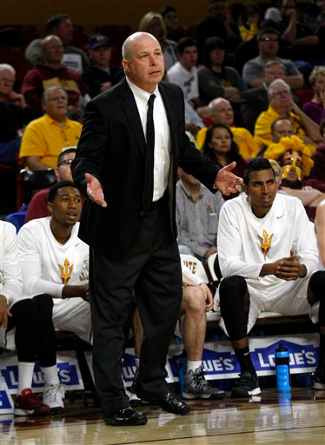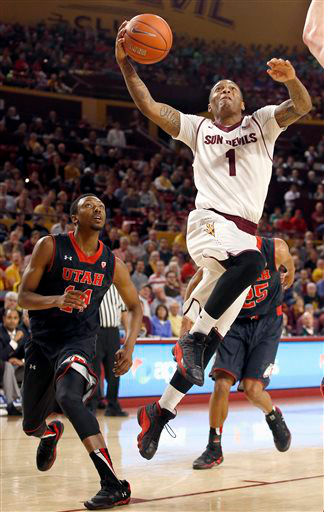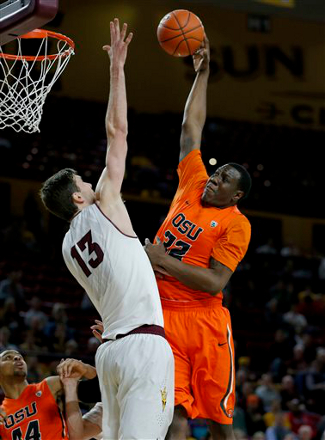NCAA Men’s Basketball Championship — Midwest Region — Third Round
[7] Texas Longhorns (24-10) vs. [2] Michigan Wolverines (26-8)
Bradley Center | Milwaukee, WI | Tip: 4:15 CT | TV: CBS
Vegas: Michigan -4.5 | Pomeroy: Michigan, 73-69 (66%)
Stop me if you’ve heard this one before. Big-name school loses its best players and has to rely on a group of sophomores and surprising freshman. Conference coach of the year honors are bestowed upon the man at the head of the bench. Hopes are high for the team to repeat their surprising run to the Final Four from the year before.
Up until that last point, Michigan and Texas have some similarities in their storylines this season. Fresh off an appearance in the national title game, the Wolverines were expecting to lean on big man Mitch McGary (No. 4) following the departures of Trey Burke and Tim Hardaway, Jr. to the NBA. Back problems cropped up for McGary during the summer, however, and the player who burst on to the national scene in last year’s NCAA tournament was limited to just eight games this year before having to shut it down.
That injury put the Wolverines at a disadvantage in the paint in a rough-and-tumble Big 10 Conference and raised some serious questions for a team that was just 8-4 in non-conference, had suffered a questionable loss to Charlotte, and whiffed on three opportunities for marquee wins. No matter, as John Beilein simply guided his team through the landmines of an unpredictable Big 10 season to a conference title that they won by a three-game margin.
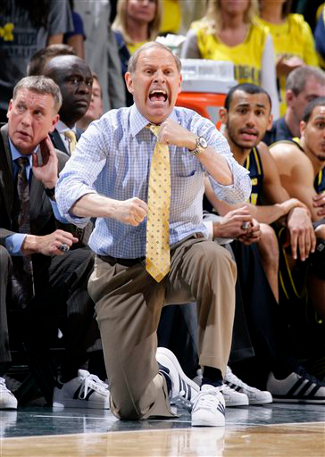
John Beilein has Michigan poised for another March run
(Photo credit: Al Goldis/Associated Press)
Although Michigan seemed to be in line for a No. 1 seed in the NCAA tournament, a loss in the Big 10 tournament championship to rival Michigan State may have been what kept the blue and maize on the 2-seed line. Thanks to the NCAA’s pod system, the Wolverines still get to play their first two games fairly close to home, in Milwaukee. However, if Friday night’s crowd was any indication, the sea of Badger red at the Bradley Center could make this feel a little more like a road game for Michigan.
By the Numbers
The Wolverines have the third-best offense in the country in terms of adjusted efficiency, according to Ken Pomeroy’s magic machines, scoring 1.214 adjusted points per possession. Michigan is incredibly patient with the basketball, works for open looks, and generally doesn’t miss once they find them. They average just 62.7 possessions per game, making them the 23rd-slowest team out of 351 D-I squads.
What is most impressive is that Michigan finds this level of offensive success without many second chances. The Wolverines reclaim just 28.8% of their missed shots, an offensive rebounding rate that puts them in D-I’s Bottom 100 in that category. To be able to score that efficiently without offensive boards takes a combination of great ball control and excellent shooting. Michigan coughs it up on only 14.9% of their possessions, which ranks 18th nationally.
As for the shooting, the Wolverines are absolutely deadly. Beyond the arc, Michigan makes 39.4% of its shots, which ranks 13th in the country. They take 40% of their shots from long range, which isn’t that surprising for a team that shoots the long ball so well. But even when Michigan isn’t torching the nets from three-point range, they work for great looks inside and convert them. On the season, they have made 53% of their two-point field goals, a stat is once again near the top of the national charts, ranking 20th.
While the Texas defense will have its hands full trying to slow down the Michigan attack, the Horns should be able to find a little more success on the other side of the ball. The Wolverines are allowing an adjusted 1.009 points per possession, a number that is up significantly from the stats that Beilein’s teams usually put up. The Wolverines have had lapses where they allow dribble penetration, they are typically exploited inside by bigger teams, and they have also had some issues getting set to stop the secondary break.
For the second-straight game, the Longhorns are facing a team that does not force too many turnovers, something that comes as a relief for a young backcourt that sometimes struggles with ball control. The Wolverines only force opponents into possession-ending mistakes 17.2% of the time, so Texas will likely not see much in the way of pressure this afternoon. As a result, the Longhorns should only have to avoid frustrating unforced errors that would make it tough to keep up with Michigan’s highly-efficient offense.
Meet the Wolverines
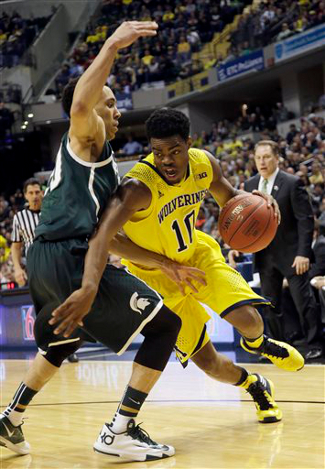
Derrick Walton, Jr. is a dynamic point guard
(Photo credit: AJ Mast/Associated Press)
It isn’t easy for a freshman point guard to follow in the footsteps of a consensus All-American, National Player of the Year, and Cousy Award winner. Is 6’1″ Derrick Walton, Jr. (No. 10) Trey Burke? Of course not. But the freshman guard has performed admirably while having to fill the shoes of a legend, posting an assist rate north of 20% while also drilling more than 40% of his threes.
Walton has an incredibly quick first step to beat tight defenses, and he couples that burst with a hesitation dribble that keeps defenders guessing. He also showed an incredible amount of hustle and scrappiness in a road win against Ohio State — the program’s first in its last ten tries — where he posted 10 rebounds despite being the smallest player on the court.
Although it’s Walton that runs the show, it’s 6’6″ Canadian product Nik Stauskas (No. 11) that gets the ink. He has made 45.1% of his three-pointers on the year, a number that’s even more impressive when you see just how closely Big 10 opponents guarded him throughout the season. Stauskas also improved his slashing ability this season, and he repeatedly puts the ball on the deck to punish opponents who overplay him on the perimeter.
Stauskas needs very little time or space to get his shot off, so defenses really have to completely deny him the ball to have any chance of stopping him. Even with a defender in his face, Stauskas often uses a quick crossover to earn just a sliver of space, which is all he needs to rise up and can a triple.
While guarding Stauskas will be enough of a chore for the Longhorns today, they also have to deal with another 6’6″ shooter in freshman Caris LeVert (No. 23). Like Stauskas, LeVert can elevate quickly and get his three-pointers up over the defense, but he also has driving ability to exploit tight defenses. His height and athleticism make him a very tough cover on the wing, and he can get to the rim in an instant with his long strides.
With Stauskas and LeVert bringing so much length to the perimeter, the Texas guards are going to find it difficult to simply face up and drive the gaps this afternoon. If the Longhorns are patient, they will find cracks in Michigan’s defense, but they have been frustrated this season by teams with similar length and have not exercised the patience necessary to find good looks. If Texas falls into that same trap this afternoon, it will be very difficult to pull off an upset.
Glenn Robinson III (No. 1) is yet another athletic 6’6″ player for the Wolverines, and he will be involved in a pair of interesting mismatches this afternoon. On defense, he will clearly be undersized against the likes of Jonathan Holmes or Connor Lammert. Although Michigan could play a zone to offset the size difference, they have typically stuck with the man defense this year, even against bigger teams like Michigan State. On the other end of the court, Robinson’s athleticism and ability to slash will be tough for those same two Longhorns to stay in front of, and a zone would likely be a death sentence against the outside shooting of Michigan.
Inside, 6’8″ senior Jordan Morgan (No. 52) will have his hands full against Cameron Ridley this afternoon. Morgan has performed admirably this season, having to step into a much different role than he had envisioned prior to McGary’s injury. On a team that does not clean the offensive glass, Morgan’s 12.6% offensive rebounding rate is incredibly impressive. The 19.5% mark he posts on the defensive end is also a big part of the team’s success on that side of the boards, where they are surprisingly ranked 54th in the country.
Backing up Morgan down low is Jon Horford (No. 15), a 6’10” big who will be very important against the Texas frontcourt this afternoon. In last Sunday’s Big 10 title game, Michigan State’s Adreian Payne quickly tagged Horford with two fouls and Morgan with one in a single possession, putting Horford on the bench just 96 seconds into the game. That forced little-used Max Bielfeldt (No. 44) into action early, a fate that Michigan sorely wants to avoid this afternoon.
In the backcourt, Michigan relies on Zak Irvin (No. 21) and Spike Albrecht (No. 2) off the bench. Irvin is another 6’6″ guy with a deadly outside stroke, but unlike the other Michigan marksmen, he doesn’t like to put the ball on the floor and try to attack with the bounce. Irvin has taken 74.6% of his shots from beyond the arc, and averages roughly four three-point attempts per game, despite seeing the court for just 15.8 minutes per game.
While Albrecht is best known for his three-point barrage against Louisville in last year’s title game (and day-after tweet to Kate Upton), he is truly a facilitator. He has seen some important minutes in crunch time this year, giving the Wolverines a steady ballhandler who creates looks for his teammates. Yes, Albrecht still shoots 39% from long range and can’t be given space, but it’s his 25% assist rate that has made him even more dangerous this season.
Keys to the Game
1) Dominate the paint – It’s going to be a battle of styles this afternoon, and whichever team does a better job imposing its will on the other will likely be advancing to Indianapolis. Michigan will obviously try to take away the paint for Texas, whether that is by using a sagging man defense or just going zone and daring a poor-shooting Longhorn team to beat them with jumpers. The Longhorns have to play their style of basketball and be persistent in getting points in the paint. If they fail to do that and just hope to win with another crazy shooting performance like they had on Friday night, the upset odds look very long.
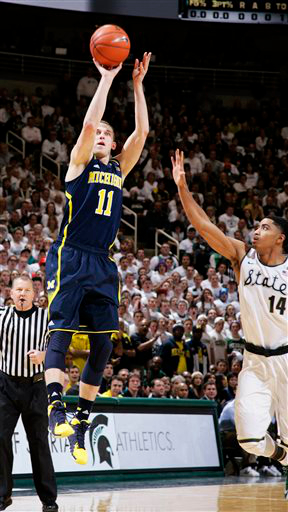
Nik Stauskas is a three-point marksman
(Photo credit: Al Goldis/Associated Press)
2) Limit perimeter damage – With so many great shooters on the perimeter for Michigan, the Longhorns are going to have a very tough time shutting down the three-point threat. Add in the significant size advantage that Michigan enjoys at the two and the three, and the defensive assignment is even tougher for the Horns. Demarcus Holland will have to use his length to try to stifle Stauskas, and needs to play him high to not only deny the ball, but also funnel him baseline to the waiting shot blockers if he tries to go backdoor.
To guard LeVert, the Longhorns might need to call on Martez Walker for big minutes once again. The freshman has seen an increased role in the last three weeks, and his ability to limit dribble penetration and use his length to challenge outside shots are a big reason for that extra playing time. Although Javan Felix is a sophomore leader on this team, his size is a defensive liability against Michigan, so fans have to hope Walker can step up and help to limit the damage.
3) Dictate the tempo – Michigan’s lethargic pace is a direct result of their patience on offense, plus the fact that opponents usually have to exercise the same patience and move the ball quickly to find the cracks in Michigan’s defense. If the Longhorns can get out and run, they will find that the Wolverine defense is not only questionable in transition, but they also often fail to recover quickly enough to stop the secondary break.
An up-tempo game has also proven to throw Michigan’s offense out of sync, as seen in their early-season loss to Iowa State. The Cyclones and Wolverines played 74 possessions in that game, and Michigan shot just 8-of-29 from long range. While the Wolverines missed some shots they usually doesn’t, they also took quite a few early threes, rather than getting the great looks that their methodical offense typically earns. If Texas can force Michigan into speeding things up a little this afternoon, the Horns have a much better chance to finally return to the Sweet Sixteen.
| 










